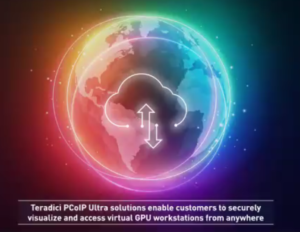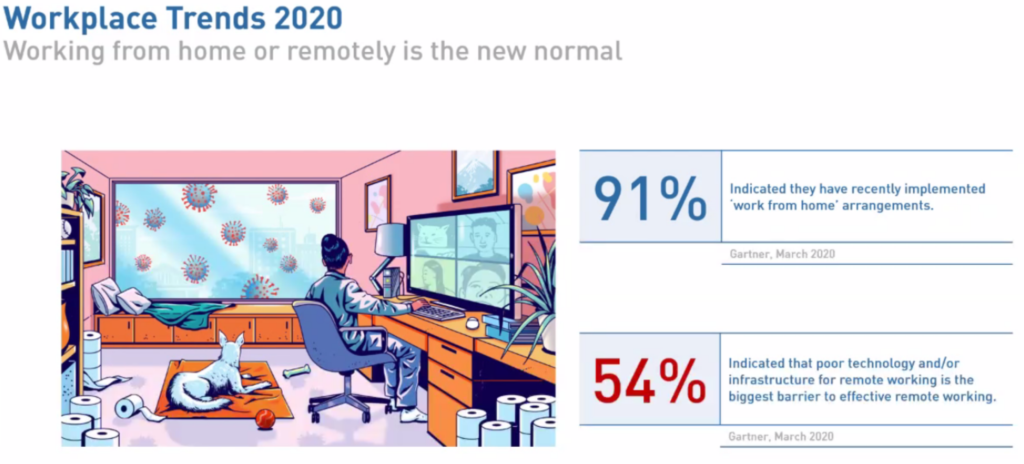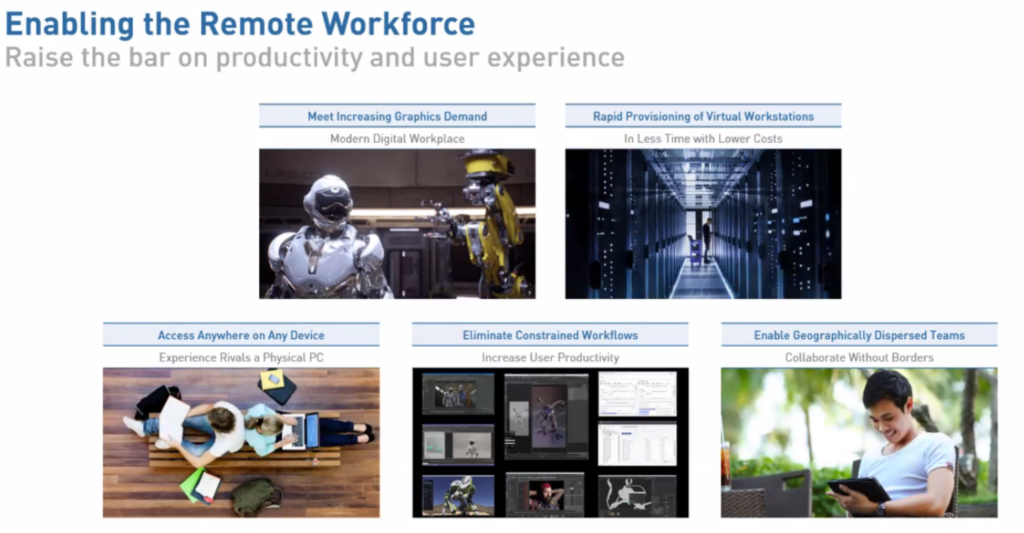
How Teradici Can Help M&E Companies Achieve Secure Virtual Visualization From Anywhere
With remote capabilities more important for companies than ever before, Teradici’s software, when paired with the Nvidia RTX Server and Quadro RTX 6000 and RTX 8000 graphics cards, provide media and entertainment companies with significant virtualization capabilities, according to the companies.
“Teradici PCoIP Ultra solutions have the ability to enable customers to securely visualize and access virtual GPU workstations from anywhere,” Kevin Ottomeyer, director of Solutions Architecture at Teradici said Sept. 24 during the webinar “Secure Virtual Visualization From Anywhere.”
And “when we say anywhere, we do mean anywhere and everywhere – securely and with high accuracy and color quality,” he noted.
What’s more, “even though we do call it Cloud Access Software, it is a solution that is available both on-prem, in the cloud and in a physical workstation environment,” he pointed out.
 PCoIP, he explained, is a “multi-codec remote display protocol that allows our customers to be able to have high accuracy in color and visualization displayed from the data center to an end point of their choosing.” Currently, Teradici has “over 15 million active users” of PCoIP worldwide, he noted.
PCoIP, he explained, is a “multi-codec remote display protocol that allows our customers to be able to have high accuracy in color and visualization displayed from the data center to an end point of their choosing.” Currently, Teradici has “over 15 million active users” of PCoIP worldwide, he noted.
Amid the “current landscape” created by the COVID-19 pandemic and “some new work-from-home initiatives… we fit very well into the current and pressing need of creative design and accuracy” for companies and sectors that include media and entertainment, he said.
Teradici’s solution, after all, securely provides remote access to customers, provides a great user experience, performs well from the data center and is easy to maintain and deploy, he said.
Combined with Nvidia’s RTX server, Teradici Cloud Access Software “enables content creators, designers and other professionals to deliver… graphics solutions where others fail in the process,” he told viewers.
Teradici is able to achieve that because of the “ability to leverage the RTX technology via” Nvidia’s Quadro graphics cards and the Nvidia Virtual Data Center Workstation (vDCW)-based licensing to deliver “color accurate workloads to our customers,” he said.
One of the primary components of Teradici Cloud Access Software is the Teradici Cloud Access Software Agent that he explained “binds in the virtual and physical workstation to the RTX Quadro and vDWS drivers to be able to deliver those streams highly accurate because they are raw streams that come from that card.”
The Teradici solution also “has some resiliency as far as bandwidth and latency-dependent connections,” he said, explaining: “What we do, built into our algorithm, gives us the dynamic ability to tune your experience up and down, based upon the integrity of the line that you’re connecting from and to.”
 That, he pointed out, “then allows our workforce — or our customers’ workforce — to have a more diverse solution to deliver to their content creators and whoever is consuming the product.” Those users are “able to access the virtual workstation with the same interactivity and color quality that they [had] when they were working in the office with a physical workstation,” he added.
That, he pointed out, “then allows our workforce — or our customers’ workforce — to have a more diverse solution to deliver to their content creators and whoever is consuming the product.” Those users are “able to access the virtual workstation with the same interactivity and color quality that they [had] when they were working in the office with a physical workstation,” he added.
One of the issues that Teradici has “experienced with a lot of our customers is that the RTX 6000 and 8000 [are] accelerating a lot of the use of virtualization,” he went on to tell viewers. Up until Nvidia introduced them, “we didn’t see a high adoption rate in virtualization: We saw a lot of physical machines, we saw a lot of cloud — but now we’re seeing an active participation in [proof of concepts] and production deployments of virtualization with Cloud Access” along with the Nvidia-based graphics cards, he said.
Noting that Teradici PCoIP Ultra is the “next generation” of its PCoIP protocol, he said it is “able to deliver a built-to-lossless image quality at 4K UHD 30 and 60 frames per second.”
The “high fidelity color accuracy” and what it is doing with Japanese manufacturer Wacom and some other partners in the peripheral space are among “the reasons why we’ve seen a high adoption rate in a lot of our media and entertainment customers,” he said.
Meanwhile, “one of the big advantages of being able to leverage” the graphics processing unit (GPU) offloading capability versus central processing unit (CPU) processing is “if some of your customers or users have bandwidth constraints [or] latency constraints, you’re able to switch over to GPU and give them a better experience as far as playback and pixel quality,” he explained.
And Teradici Cloud Access Manager, which is included in all Cloud Access subscriptions, is “an overall ecosystem of services and features that allow us and our IT customers to get a little bit more flexibility and manageability,” he pointed out.
 “What we’ve seen a lot of is customers that were traditionally using” a virtual private network (VPN)-based technology before the pandemic were “relying on that VPN technology” for their remote use cases, he said, adding: “Data was being copied back and forth [and] there was congestion on the line. Implementing Teradici Cloud Access Manager, along with Teradici Cloud Access Plus, allowed them to ditch their VPN and use our AES256-encrypted micro VPN tunnel that’s included in the Teradici Cloud Access Manager.”
“What we’ve seen a lot of is customers that were traditionally using” a virtual private network (VPN)-based technology before the pandemic were “relying on that VPN technology” for their remote use cases, he said, adding: “Data was being copied back and forth [and] there was congestion on the line. Implementing Teradici Cloud Access Manager, along with Teradici Cloud Access Plus, allowed them to ditch their VPN and use our AES256-encrypted micro VPN tunnel that’s included in the Teradici Cloud Access Manager.”
As a result, “no longer are they constrained to the throughput of their VPN,” he said, noting they were instead “able to leverage over the Internet an encrypted and secure-based way of connecting to their virtual workstations in the cloud or on-prem.”
Teradici also gives customers “the ability to leverage” application programming interfaces (APIs) “to facilitate any kind of automation that they need to do inside of their current environment,” he added.
Customers who have been successful in deploying these Teradici solutions include British visual effects and animation studio Double Negative (DNEG) and the Vancouver Film School, he noted.
